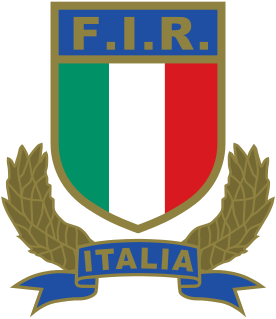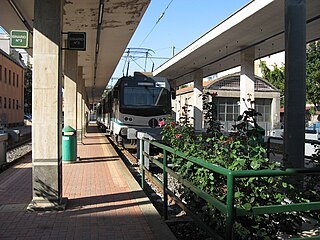
Pier Luigi Nervi was an Italian engineer and architect. He studied at the University of Bologna graduating in 1913. Nervi taught as a professor of engineering at Rome University from 1946 to 1961 and is known worldwide as a structural engineer and architect and for his innovative use of reinforced concrete.

The Italy national rugby union team represents Italy in men's international rugby union. The team is known as gli Azzurri. Savoy blue is the common colour of the national teams representing Italy, as it is the traditional colour of the royal House of Savoy which reigned over the Kingdom of Italy from 1860 to 1946.

The Stadio Flaminio is a stadium in Rome. It lies along the Via Flaminia, three kilometres northwest of the city centre, 300 metres away from the Parco di Villa Glori.

Magliano Romano is a comune (municipality) in the Metropolitan City of Rome in the Italian region Latium, located about 30 kilometres (19 mi) north of Rome.

Morlupo is a comune (municipality) in the Metropolitan City of Rome in the Italian region Latium, located about 30 kilometres (19 mi) north of Rome.

Rignano Flaminio is a comune (municipality) in the Metropolitan City of Rome in the Italian region Latium, about 35 kilometres (22 mi) north of Rome. It is across the Via Flaminia.
The football tournament at the 1960 Summer Olympics was held from 26 August to 10 September in 1960 throughout Italy. The tournament featured 16 men's national teams from four continental confederations. The 16 teams were drawn into four groups of four and each group played a round-robin tournament. At the end of the group stage, the first-ranked teams of each group advanced to the semi-finals, and culminating with the gold medal match in Rome on September 10, 1960.

Flaminio Ponzio (1560–1613) was an Italian architect during the late-Renaissance or so-called Mannerist period, serving in Rome as the architect for Pope Paul V.

Flaminio–Piazza del Popolo is an underground station on Line A of the Rome Metro, inaugurated in 1980. The station is situated on the large Piazzale Flaminio, in the Flaminio quarter outside the Aurelian Walls, next to Piazza del Popolo, and is near the Campus Martius.

Giovanni Vasanzio or Jan van Santen (c.1550–1621) was a Dutch-born architect, garden designer and engraver who spent his mature career in Rome, where he arrived in the 1580s.
Società Sportiva Alba-Audace was an Italian football club from the Flaminio area of Rome, founded in 1907. The club is most noted for competing in the early Italian Football Championship competitions, before becoming one of three Rome based clubs merging to form AS Roma in 1927.

Flaminio Vacca or Vacchi was an Italian sculptor. His sculptural work can be seen in Rome in the grandiose funeral chapel of Pope Pius V designed by Domenico Fontana at the Basilica di Santa Maria Maggiore, in the Church of the Gesù and in the right transept of the Chiesa Nuova. At the notoriously awkward fountain that marked the terminus of the Acqua Felice, Vacca contributed one of the angels supporting Sixtus V's coat-of-arms that crown the attic, and a bas-relief Joshua Leading His People across the Jordan River; in these commissions for the fountain his partner in the documented payments was Pietro Paolo Olivieri. His self-portrait (1599) is conserved in the Protomoteca Capitolina on the Campidoglio. At the Villa Medici the two marble Medici lions flank the staircase; one is Roman, its pendant, made to match it in 1600, was by Flaminio Vacca. Vacca's copy was replaced by a copy when Villa Medici was sold by the Grand Duke of Tuscany and moved the lions to Piazza della Signoria, Florence, where with its ancient companion it flanks the steps to the Loggia dei Lanzi. In Santa Susanna, the prophets Ezekiel and Daniel have been attributed to him.

Marcantonio Flaminio, also known as Marcus Antonius Flaminius, was an Italian humanist poet, known for his Neo-Latin works. During his life, he toured the courts and literary centers of Italy. His editing of the popular devotional work, the "Beneficio di Cristo" illustrated a hope that the Catholic church would move closer to some of the thinking of the protestant reformers.

The current Rome tram system is a leftover from what once was the largest tram system in Italy. With its fragmented structure, it does not currently function as a backbone of the city's public transport. The system is owned and operated by Azienda Tranvie e Autobus del Comune di Roma.

The Rome–Civita Castellana–Viterbo railway is a regional railway line connecting Rome, Italy, with Viterbo, capital city of the Province of Viterbo. The 102 km (63 mi) long line, also known in Rome as the Roma Nord line, after its former concessionaire, is part of Rome's metropolitan and regional railway network.

The Flaminio Obelisk is one of the thirteen ancient obelisks in Rome, Italy. It is located in the Piazza del Popolo.

Ponte Duca d'Aosta is a bridge that links Lungotevere Flaminio to Piazza Lauro De Bosis, in Rome (Italy), in the Flaminio and Della Vittoria quarters.

Piazza Farnese, in Rome, is the main square of the Regola district.
This page is based on this
Wikipedia article Text is available under the
CC BY-SA 4.0 license; additional terms may apply.
Images, videos and audio are available under their respective licenses.














